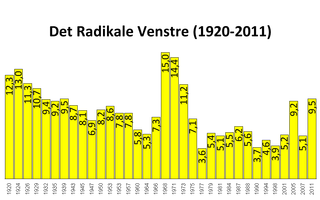 |
|---|
| This article is part of a series on the politics and government of Denmark |
|
|
The Danish local elections of 2005 were held on 15 November 2005. 2522 municipal council members were elected in Denmark's 98 municipalities and 205 regional council members in the five regions. Most of these were newly formed municipalities, namely 66 municipalities, that would only begin working from Monday 1 January 2007, as would the newly formed regions, and one municipality, Ærø, which was also part of the reform, which was allowed by the government to commence work for the first time already Sunday 1 January 2006. So the first term of office in this newly created municipality was the whole period of four years from 2006 until 2009. The 238 municipal councils (Danish: kommunalbestyrelser;singular: kommunalbestyrelse) and 13 county councils that were to be abolished 1 January 2007 just continued their work one year more than the term of office (2002-2005) they were elected for until 31 December 2006 and then ceased to exist. Among the remaining 31 municipalities having their new councils elected was Bornholm Regional Municipality that was formed and began its work 1 January 2003. This was only the second time it had a new council elected, the first time being in November 2001, and it was the first time its council served the whole term of office. Bornholm's merger was not a part of the reform, having been decided by the island's voters already in May 2001. It was the new center-right government elected at the end of 2001 that drove the reform through parliament. The 30 municipalities that remained were not merged with other municipalities, so their newly elected councils served the whole term of office 1 January 2006 until 31 December 2009.
Denmark is divided into five regions, which contain 98 municipalities. This structure was established per an administrative reform of the public sector of Denmark, effective 26 June 2005, which abolished the 13 counties and created five regions which unlike the counties (1970-2006) are not municipalities. The 270 municipalities were consolidated into 98 larger units, most of which have at least 20,000 inhabitants.

Denmark, officially the Kingdom of Denmark, is a Nordic country and the southernmost of the Scandinavian nations. Denmark lies southwest of Sweden and south of Norway, and is bordered to the south by Germany. The Kingdom of Denmark also comprises two autonomous constituent countries in the North Atlantic Ocean: the Faroe Islands and Greenland. Denmark proper consists of a peninsula, Jutland, and an archipelago of 443 named islands, with the largest being Zealand, Funen and the North Jutlandic Island. The islands are characterised by flat, arable land and sandy coasts, low elevation and a temperate climate. Denmark has a total area of 42,924 km2 (16,573 sq mi), land area of 42,394 km2 (16,368 sq mi), and the total area including Greenland and the Faroe Islands is 2,210,579 km2 (853,509 sq mi), and a population of 5.8 million.

The five Regions of Denmark were created as administrative entities at a level above the municipalities and below the central government in the public sector as part of the 2007 Danish Municipal Reform, when the 13 counties (amter) were abolished. At the same time, the number of municipalities (kommuner) was cut from 270 to 98.



